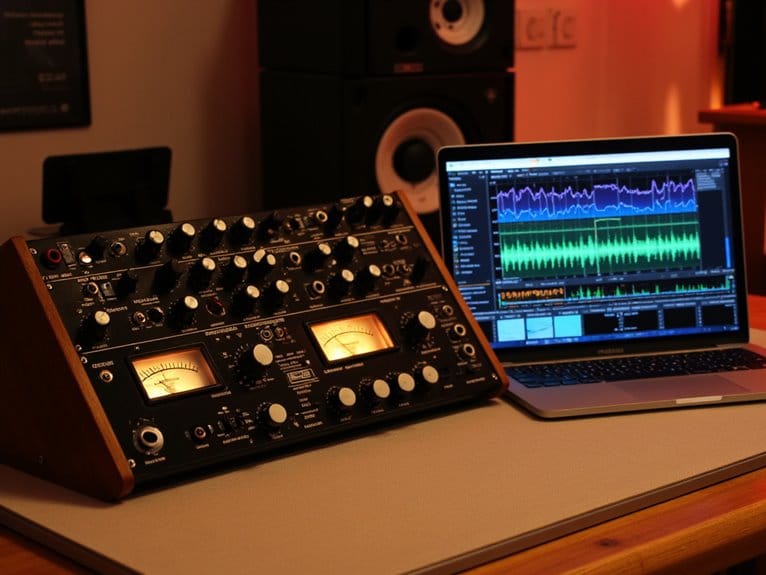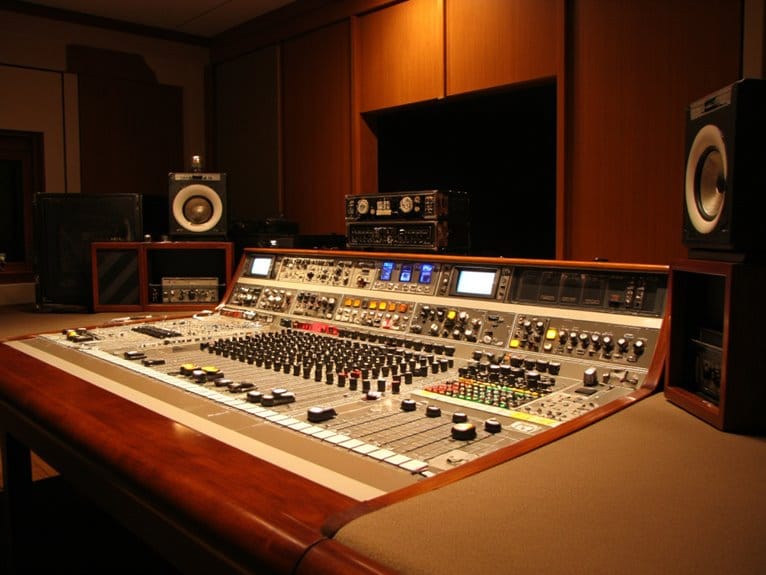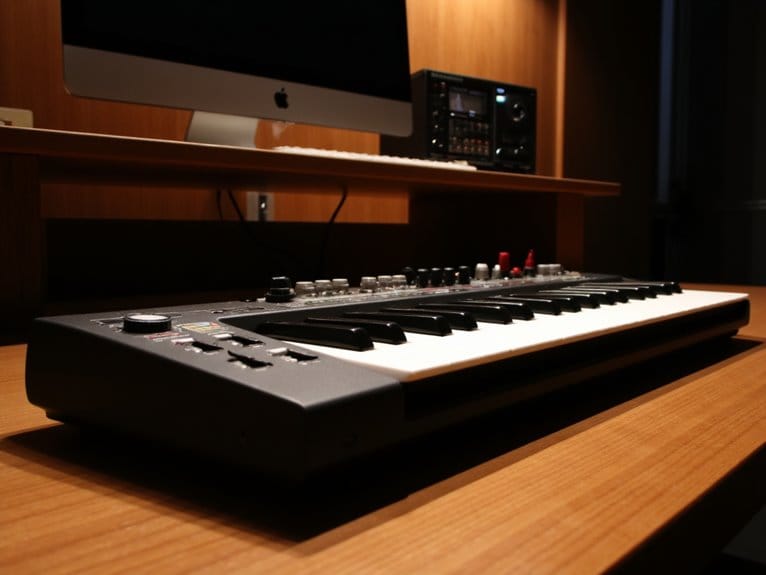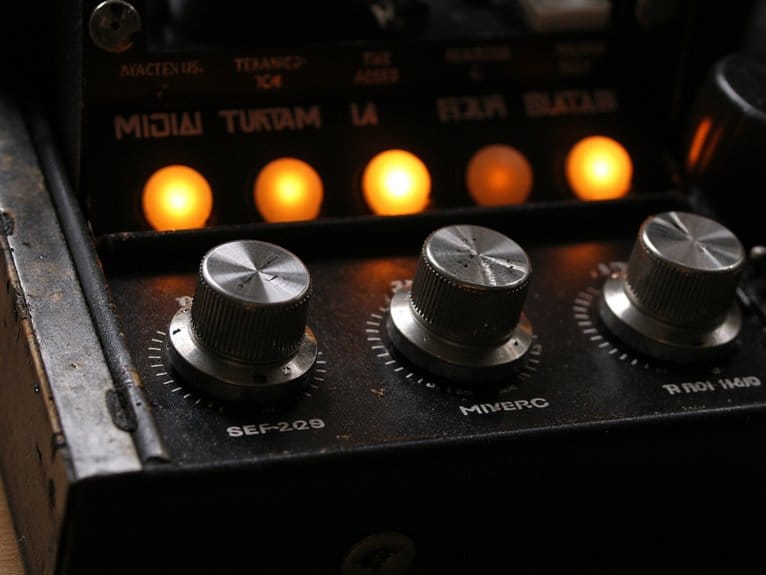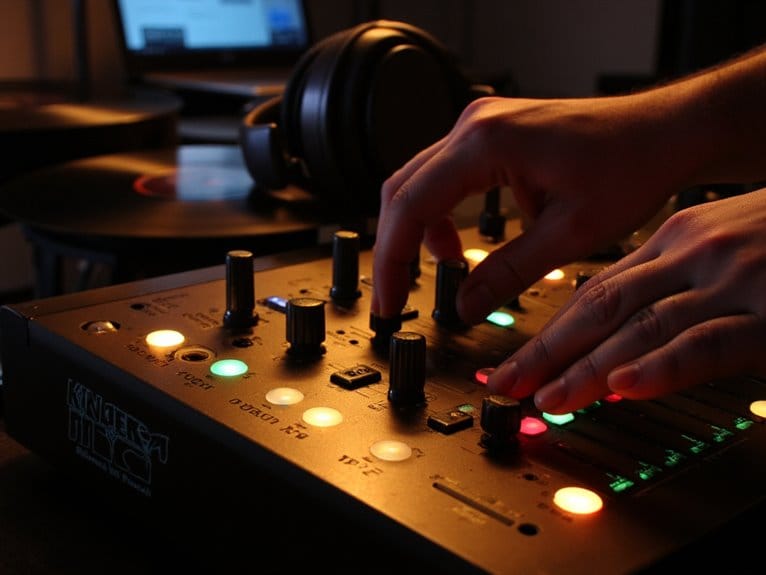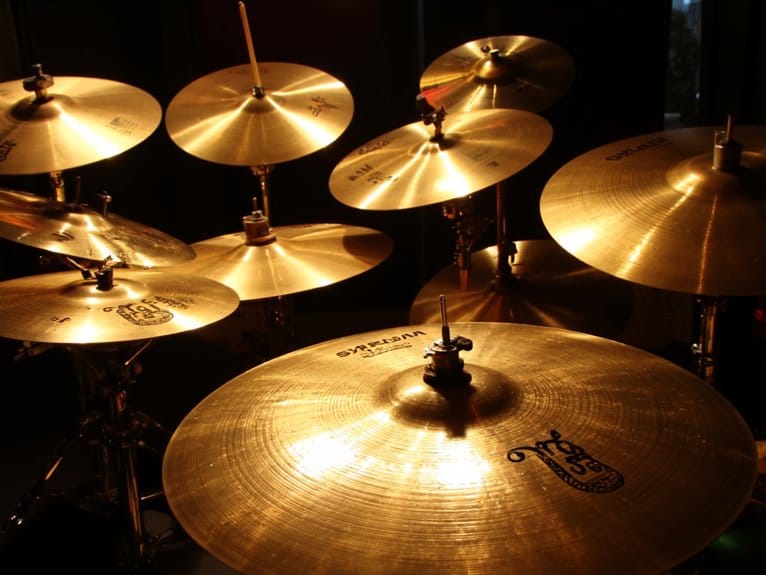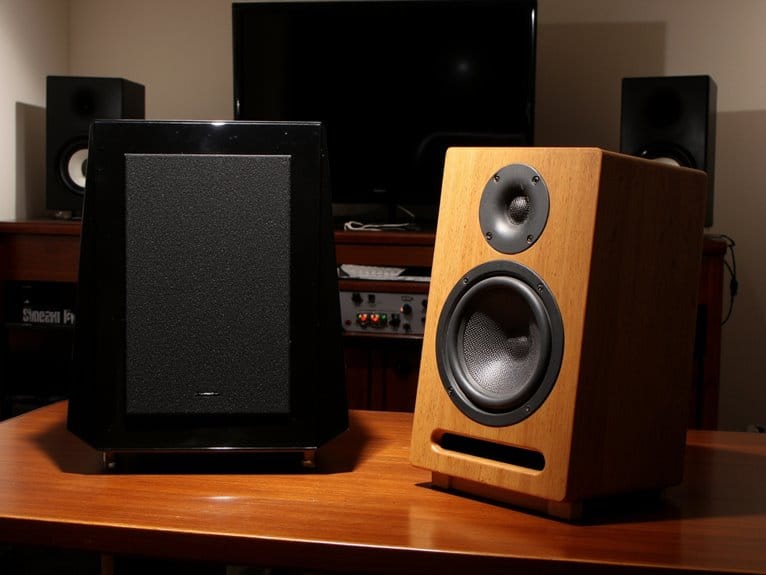Hardware Vs Software Synthesizers: Pros and Cons
You’ll find hardware synthesizers offer zero-latency performance with tactile knobs and sliders for immediate sound shaping, though they’re heavier (5-60 pounds), cost more upfront ($300+), and require dedicated space. Software synthesizers provide unlimited sonic variety, seamless DAW integration, and laptop portability at lower entry costs (free-$200), but they lack physical feedback and can face latency or compatibility issues. Hardware holds resale value while software creates sunk costs, and combining both approaches often yields the most extensive setup for exploring deeper production possibilities.
We are supported by our audience. When you purchase through links on our site, we may earn an affiliate commission, at no extra cost for you. Learn more.
Notable Insights
- Hardware synths offer zero latency and tactile control, while software provides unlimited variety and superior DAW integration.
- Software synths cost $0-200 with no resale value; hardware starts at $300 but maintains strong resale potential.
- Hardware weighs 5-60 pounds requiring dedicated space; software only needs a laptop for complete portability.
- Hardware delivers consistent performance and intuitive control; software faces potential crashes but offers extensive processing capabilities.
- Software setup takes 2-5 minutes versus 15-30 minutes for hardware with multiple cables and power requirements.
Sound Quality and Variety Comparison
When you’re choosing between hardware and software synthesizers, the sound quality debate often centers on latency, character, and consistency—three factors that can make or break your creative workflow.
Hardware units deliver immediate sound generation with zero latency, while software synths depend on your computer’s CPU and optimized ASIO drivers to minimize delays.
The sound fidelity conversation gets interesting when you consider tonal characteristics: analog hardware provides that warm, sometimes imperfect character musicians crave, though modern software like u-he Diva successfully emulates these nuances. Additionally, hardware synthesizers require analog to digital conversion when recording, which can introduce potential noise and interference compared to software’s pristine internal audio processing.
Software offers virtually unlimited variety through extensive processing power, while hardware’s physical constraints create narrower but often more distinctive sonic territories. Hardware instruments can be physically interacted with for unique sound manipulation techniques that software interfaces cannot replicate.
Many modern software synthesizers include 24-bit/192kHz recording quality that matches professional studio standards, providing exceptional clarity for digital productions.
Ultimately, both approaches can achieve professional results.
User Interface and Playability Differences
Sound quality matters, but the way you interact with your synthesizer shapes your creative process just as much as the audio it produces.
Hardware synths excel in tactile feedback, offering immediate access to knobs, sliders, and buttons that let you tweak parameters while playing, creating an intuitive, hands-on experience that enhances live performances. Many hardware synths feature built-in sequencers that allow musicians to quickly capture and develop musical ideas without external equipment.
Hardware synthesizers transform sound design into a physical art form where every knob turn becomes an extension of musical expression.
Software synths prioritize workflow efficiency through seamless DAW integration, instant patch recall, and customizable visual interfaces with detailed oscilloscope displays and modulation routing diagrams. However, they rely on mouse navigation and menu systems that can interrupt your creative flow.
While hardware demands manual re-patching that consumes precious studio time, it provides muscle-memory access to controls without constant screen monitoring, making real-time sound shaping feel more natural and expressive. Hardware synthesizers also offer crucial connectivity options including CV outputs, USB, and MIDI support that enhance integration with external gear and modular setups.
Portability and Space Considerations
Everything about your musical setup changes when you factor in where you’ll actually use your synthesizers, and I’ve learned this lesson the hard way after lugging a 60-pound workstation up three flights of stairs more times than I care to admit.
| Aspect | Hardware Synths | Software Synths |
|---|---|---|
| Weight | 5-60 pounds each | Laptop weight only |
| Setup Time | 15-30 minutes | 2-5 minutes |
| Required Gear | Power supply, cables, travel cases | MIDI controller, audio interface |
| Storage Space | Dedicated racks/stands | Virtual storage |
| Transport Cost | Multiple cases, careful handling | Single laptop bag |
Software synthesizers transform your entire studio into something that fits in a backpack, while hardware demands dedicated space, protective travel cases, and multiple power supplies for mobile use.
Cost and Investment Analysis
Three thousand dollars later, I realized I’d fallen into the classic synthesizer trap that catches both beginners and seasoned producers alike – the assumption that spending more automatically equals better music.
Your initial purchase decisions between hardware and software fundamentally shape your studio’s financial trajectory, with software offering entry points from free to $200 while hardware typically starts around $300.
The long term value proposition favors hardware through strong resale potential, often retaining significant value or even appreciating, whereas software purchases become sunk costs.
Additional equipment requirements compound hardware expenses through MIDI controllers, audio interfaces, and cables, while software leverages your existing computer setup.
Different payment models – from one-time hardware purchases to software subscriptions – demand careful evaluation of your production timeline and budget constraints.
Reliability and Learning Curve Factors
Budget considerations tell only half the story of your synthesizer investment, because the most expensive instrument becomes worthless if it crashes during your most inspired moments or takes months to master effectively.
Hardware synthesizers deliver superior performance consistency with zero latency, though they’re vulnerable to physical wear and environmental factors that create maintenance challenges over time.
Software synthesizers offer stable digital performance without degradation, but you’ll face potential crashes and compatibility issues that can interrupt your workflow.
The learning curve differs dramatically: hardware provides intuitive tactile control through physical knobs, while software requires maneuvering through complex menus and DAW integration.
I’ve found that combining MIDI controllers with software synthesizers often provides the best balance between hands-on control and digital reliability.
Frequently Asked Questions
Can I Use Both Hardware and Software Synthesizers Together in One Setup?
You can absolutely use both together through synth integration features. Configure proper MIDI routing in your DAW to connect hardware and software synths, creating hybrid setups that combine tactile control with expansive digital sound design capabilities.
Which Type of Synthesizer Is Better for Live Performances Versus Studio Recording?
You’ll find hardware synthesizers offer live performance advantages through reliable operation and tactile controls, while software synthesizers provide studio recording flexibility with vast sound libraries and seamless DAW integration for complex productions.
How Do I Properly Connect Hardware Synthesizers to My Computer and DAW?
You’ll need MIDI connections via USB or 5-pin DIN cables to send note data, plus audio interfaces to capture your synth’s sound output into your DAW for recording and processing.
On a final note
You’ll find that both hardware and software synthesizers offer compelling advantages depending on your specific needs, budget constraints, and workflow preferences. While hardware provides that tactile experience we all crave, along with dedicated controls and immediate access to parameters, software delivers incredible versatility, cost-effectiveness, and virtually unlimited polyphony. I’d recommend considering your studio space, performance requirements, and long-term musical goals before making this investment decision.

